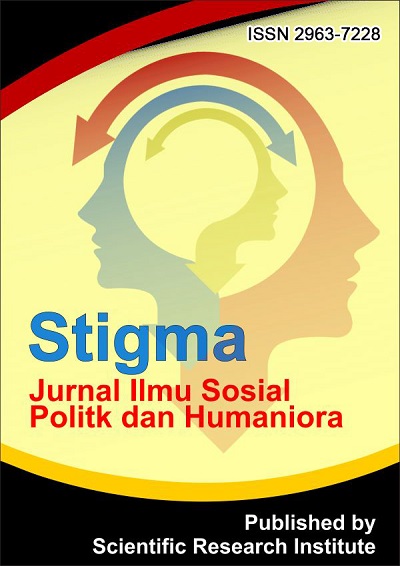Kampanye Gerakan Sosial Terhadap Isu Kesetaraan Gender Melalui Film Di Amerika Serikat Periode 2019 -2021
Keywords:
Kesetaraan gender, Gerakan Sosial, Amerika SerikatAbstract
This study presents a campaign on gender equality issues in American films through film observation using gender as a perspective in international relations, focusing on three films: Captain Marvel (2019), Wonder Woman 1984 (2020), and Reign of Superwomen (2021) as films that contain representations of gender issues in American cinema during the period of 2019-2021. Gender studies and film theory provide a framework for analyzing gender representations in films and understanding their significance. Based on the gender equality issues occurring in the United States, this drives a social movement reflected in the perspectives of women who work behind the scenes in filmmaking, encompassing women's experiences related to gender social injustices.
References
Abad-Santos, A. (2019). How Captain Marvel and Brie Larson beat the internet’s sexist trolls. Vox. https://www.vox.com/culture/2019/3/8/18254584/captain-marvel-boycott-controversy
Adlini, M. N., Dinda, A. H., Yulinda, S., Chotimah, O., & Merliyana, S. J. (2022). Metode penelitian kualitatif studi pustaka. Jurnal Edumaspul, 6(1), 974–980.
Agnew, J. C., & Rosenzweig, R. (Eds.). (2002). A companion to post-1945 America (Vol. 18, p. 584). Malden: Blackwell.
Agustina, M. D. (2022). The struggle of woman emancipation in the movie On the Basis of Sex: A feminist criticism. ENLIT, 2(1), 51–61.
Aiello, G. (2020). Visual semiotics: Key concepts and new directions. In The SAGE handbook of visual research methods (pp. 367–380). SAGE.
Bazzi, S., Brodeur, A., Fiszbein, M., & Haddad, J. (2023). Frontier history and gender norms in the United States (No. w31079). National Bureau of Economic Research.
Benshoff, H. M., & Griffin, S. (2003). America on film: Representing race, class, gender, and sexuality at the movies. Wiley-Blackwell.
Bowers, C. A. (1990). Implications of Gregory Bateson’s ideas for a semiotic of art education. Studies in Art Education, 31(2), 69–77.
Bucciferro, C. (2021). Representations of gender and race in Ryan Coogler’s film Black Panther: Disrupting Hollywood tropes. Critical Studies in Media Communication. https://doi.org/10.1080/15295036.2021.1889012
Campuzano, M. V. (2019). Force and inertia: A systematic review of women’s leadership in male-dominated organizational cultures in the United States. Human Resource Development Review. https://doi.org/10.1177/1534484319861169
Casad, B. J., Garasky, C. E., Jancetic, T. R., Brown, A. K., Franks, J. E., & Bach, C. R. (2022). US women faculty in the social sciences also face gender inequalities. Frontiers in Psychology, 13, 792756. https://doi.org/10.3389/fpsyg.2022.792756
Chi, P. (2017). Brie Larson says not clapping for Casey Affleck at the Oscars ‘speaks for itself’. Vanity Fair. https://www.vanityfair.com/hollywood/2017/03/brie-larson-casey-affleck-not-clapping-oscars-best-actor
Cole, J. (2018). The hidden power of superheroes: The ability of superhero movies to influence political attitudes.
Congress, G. (2017). A bill to prevent international violence against women, and for other purposes. https://www.congress.gov/bill/115th-congress/senate-bill/2120
Congress, G. (2019). International Violence Against Women Act of 2019. https://www.congress.gov/bill/116th-congress/senate-bill/3037
Cornelsen, K. (2005). Women Airforce Service Pilots of World War II: Exploring military aviation, encountering discrimination, and exchanging traditional roles in service to America. Journal of Women’s History, 17(4), 111–119.
Curtis, N. (2020). Wonder Woman and Captain Marvel: The (dis)continuity of gender politics. The Journal of Popular Culture. https://doi.org/10.1111/jpcu.12942
Eisend, M. (2019). Gender roles. Journal of Advertising, 1–9. https://doi.org/10.1080/00913367.2019.1566103
Emily, W. W. T. (2020). The change in gender representation in superhero movies of the last decade. Exemplary Capstone Project, Department of English, The Chinese University of Hong Kong, 417.
Escandon, R. (2020). Sexual harassment still prevalent in Hollywood even after the #MeToo movement, survey finds.
Erliska, E. (2017). [Retracted] Power and gender oppression in Lauren Weisberger’s The Devil Wears Prada and Seth Graham Smith’s Pride and Prejudice and Zombies. Bahasa dan Seni: Jurnal Bahasa, Sastra, Seni, dan Pengajarannya, 45(2), 2.
Frye, J., Buchanan, M. J., Bleiweis, R., Phadke, S., Ahmed, O., & Corley, D. (2019). Transforming the culture of power: An examination of gender-based violence in the United States.
Guerrasio, J. (2019). Wonder Woman director Patty Jenkins knows fighting for her own equal pay helps other women in Hollywood. Business Insider. https://www.businessinsider.in/wonder-woman-director-patty-jenkins-knows-fighting-for-her-own-equal-pay-helps-other-women-in-hollywood/articleshow
Hollands, R., & Vail, J. (2012). The art of social movement: Cultural opportunity, mobilisation, and framing in the early formation of the Amber Collective. Poetics, 40(1), 22–43.
Iacovetta, F., & Kealey, L. (1996). Women’s history, gender history and debating dichotomies. Left History: An Interdisciplinary Journal of Historical Inquiry and Debate, 4(1).
John, N., Casey, S., Carino, G., & McGovern, T. (2020). Lessons never learned: Crisis and gender-based violence. Developing World Bioethics. https://doi.org/10.1111/dewb.12261
Karniouchina, E. V., Carson, S. J., Theokary, C., Rice, L., & Reilly, S. (2023). Women and minority film directors in Hollywood: Performance implications of product development and distribution biases. Journal of Marketing Research, 60(1), 25–51.
Kerber, L. K., Kessler-Harris, A., & Sklar, K. K. (Eds.). (2000). US history as women’s history: New feminist essays. University of North Carolina Press.
Klugman, J. (2017). Gender-based violence and the law.
Lawrence Neuman, W. (2014). Social research methods: Qualitative and quantitative approaches. Pearson.
Leavy, P., & Trier-Bieniek, A. (2014). Introduction to gender & pop culture. In Gender & pop culture (pp. 1–25). Brill.
Mappasere, S. A., & Suyuti, N. (2019). Pengertian penelitian pendekatan kualitatif. Metode Penelitian Sosial, 33.
Martin, P. Y. (2004). Gender as social institution. Social Forces, 82(4), 1249–1273.
Mason, P. (2005). Visual data in applied qualitative research: Lessons from experience. Qualitative Research, 5(3), 325–346. https://doi.org/10.1177/1468794105054458
Meade, T. A., & Wiesner-Hanks, M. E. (Eds.). (2020). A companion to global gender history. Wiley. https://doi.org/10.1002/9781119535812
Meara, K., Pastore, F., & Webster, A. (2020). The gender pay gap in the USA: A matching study. Journal of Population Economics, 33, 271–305.
Melosh, B. (2012). Gender and American history since 1890. Routledge.
Meyerowitz, J. (2008). A history of “gender.” The American Historical Review, 113(5), 1346–1356.
Miller, M. K., Rauch, J., & Kaplan, T. (2016). Gender differences in movie superheroes’ roles, appearances, and violence.
Montasseri, Z., Khaghaninejad, S., & Moloodi, A. (2020). Gender representation in American movies: A corpus-based analysis. The International Journal of Humanities, 27(4), 42–53. http://eijh.modares.ac.ir/article-27
Murtazikoh, B., & Hetami, F. (2022). Gender performance by Miranda Priestly as the main character in Weisberger’s The Devil Wears Prada. The Proceedings of English Language Teaching, Literature, and Translation (ELTLT), 11, 219–227.
Na, N. (2016). Women’s rights emerge within the anti-slavery movement, 1830–1870: A brief history with documents. Springer.
Nazilla, M. I., & Rahayu, E. Y. (2021). The depictions of gender-based discriminations in the US in Mimi Leder’s On the Basis of Sex (2018): As a feminism study. Dinamika Bahasa dan Budaya, 16(2), 104–108.
O’Connor, P. (2020). Why is it so difficult to reduce gender inequality in male-dominated higher educational organizations? A feminist institutional perspective. Interdisciplinary Science Reviews, 45(2), 207–228.
Padavic, I., Ely, R. J., & Reid, E. M. (2020). Explaining the persistence of gender inequality: The work–family narrative as a social defense against the 24/7 work culture. Administrative Science Quarterly, 65(1), 61–111.
Parvez, Y. H. (2022). Gender representation in female superhero movies. SSRN. https://doi.org/10.2139/ssrn.4221785
Pepper, M. D. (2015). Post-postmodernism and the market popularity of superhero movies. Enculturation: A Journal of Rhetoric, Writing, and Culture, 17.
Pistorius, L. (2023). The impact of the #MeToo movement on the Hollywood film industry.
Rowley, C. (2010). Popular culture and the politics of the visual. In Gender matters in global politics (pp. 335–351). Routledge.
Rowley, C., & Shepherd, L. J. (2012). Contemporary politics: Using the ‘F’ word and teaching gender in international relations. Teaching Politics and International Relations, 146–161.
Savino, D. (2024). The woman’s experience in Hollywood: A brief feminist history of the American movie industry.
Stout, N. (2019). Power and vulnerability in Knock Down the House: An interview with Rachel Lears. Anthropology Now, 11(1–2), 90–100. https://doi.org/10.1080/19428200.2019.1644867
Stover III, J. A. (2013). Framing social movements through documentary films. Contexts, 12(4), 56–58.
Streeter, S. M. (2014). The Air Force and diversity: The awkward embrace. Air & Space Power Journal, 28(2).
USSC. (2024). Sexual abuse. United States Sentencing Commission. https://www.ussc.gov/research/quick-facts/sexual-abuse
Watson, S. A. (2021). How has modern feminism and the #MeToo movement evolved sexual assault portrayal in film? (Doctoral dissertation).
Wulandari, E., & Thoyibi, M. (2022). Educating young learners to gender equality through movies: Wonder Woman vs Captain Marvel. AL-ISHLAH: Jurnal Pendidikan, 14(3), 4279–4290.
Wang, H. M., Ma, A. L., & Guo, T. T. (2020). Gender concept, work pressure, and work–family conflict. American Journal of Men’s Health, 14(5), 1557988320957522.
Downloads
Published
How to Cite
Issue
Section
License

This work is licensed under a Creative Commons Attribution 4.0 International License.
This is an open-access journal. All works are published under the Creative Commons license CC-BY which means that all content is freely available at no charge to the user or his/her Institution. Users are allowed to read, download, copy, write, improve, and create derivative creation even for other lawful purposes, this license permits anyone to, as long as they cite and license the derivative creation under similar terms

This work is licensed under a Creative Commons Attribution 4.0 International License.




